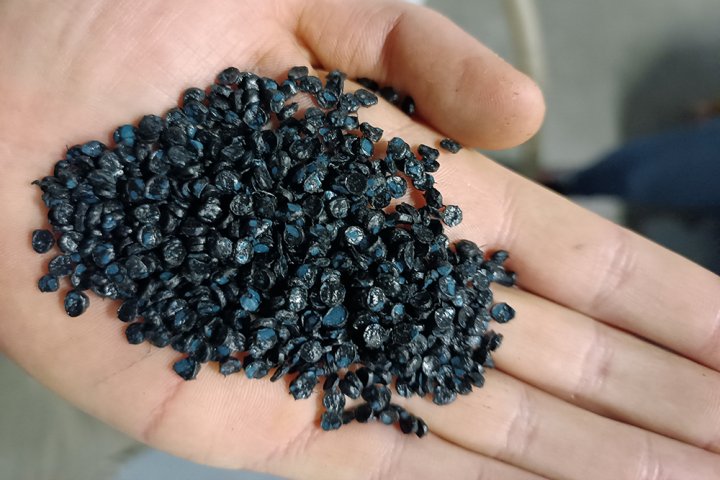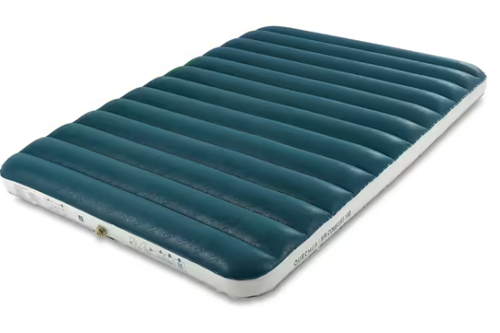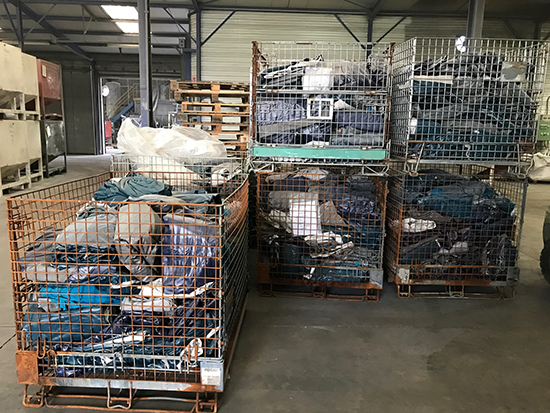“From mattress to clog, in only one step”

Initially, Decathlon wanted to recycle its inflatable camping mattress. Why did you choose this product?
Léna Defontaine: An icon of Quechua camping, this mattress is our best-selling PVC product. With 2 million units sold each year, it represents around 40% of Decathlon’s annual PVC tonnage. However, like all inflatable products, it is fragile. Despite numerous studies carried out to improve its robustness, the rate of defective returns has stagnated over the last 2–3 years. Unfortunately, we don’t have much room for manoeuvre when it comes to this type of product with such a tight price/positioning… It’s also difficult to offer a repair service in our workshop, as it wouldn’t be competitive with the price of a new mattress. We thought it would be a shame to throw these returned products in the bin, where most of them would end up in landfills or, at best, be recovered as energy. So, at the end of 2020, we set out to find a company that would be willing to help us find a more virtuous end of life for the mattress by recycling them.

|
Is this the reason why Benvic was approached by Decathlon?
Philippe Gressier: I do not really know who chose whom, but that is not the most important thing… All I can say is that this meeting left very little room for chance. Benvic is a well-known compounder, particularly for its expertise in PVC. Although we have an interest in other thermoplastic polymers and biopolymers, PVC has been at the heart of our business for almost 60 years. What’s more, since 2019 and the acquisition of Ereplast, we have been investing in its recycling. When we heard that Decathlon was looking for a company to help them study the feasibility of recycling their mattresses into clogs for gardening and outdoor leisure activities, we saw a great opportunity to make the most of our expertise.

|
Was this the case?
Philippe Gressier: I think so, because the challenges were so many. Firstly, because soft PVC is more difficult to recycle than rigid PVC, due to the different types of plasticiser and the different degrees of hardness. Most importantly, Decathlon mattresses are not made from a single material. While they are 95% soft PVC, one side is flocked with a bonded viscose for comfort (4,9%) and the valves are made of rigid PVC, ABS and silicone (0,1%). These valves are not really a problem as they can be removed.

|
Unfortunately, mechanisation is not possible. |
How did you manage?
Léna Defontaine: The first and easiest option would have been to cut off the viscose coated side, but this would have meant losing 45% of the material to be recycled. This would have been very unsatisfactory from a recycling point of view. As the viscose was glued, removing it using a scraping process was inconceivable. To separate the PVC from the textile fibres, we also investigated a dissolution and precipitation process. This proved to be too expensive compared to the value of the PVC. What’s more, the process uses a lot of energy and therefore emits a lot of CO2.
|
Philippe Gressier: After looking at all the options, we decided to shred the entire mattress once the valve had been removed and to develop a new granulate that would incorporate this 4,9% viscose. |

|
And what was the result?
Philippe Gressier: The first piece of good news was that the shredder was able to process viscose without any particular difficulty. Next, the shredded material passes through a deduster to extract a few viscose particles. Finally, it is filtered just before granulation, which reduces the number of particles again. In the end, some viscose remains, but in a smaller proportion.
But the hardest part was still to come, because we had to design granules that could be injected from this shredded material. We had to find the right granule size and the right additives to achieve a satisfactory viscosity. We succeeded, but I won’t tell you how, because that’s one of a compounder’s trade secrets and we guard it jealously… The clogs were then injected in one of Decathlon’s production centres in France and, after several tests, the result met expectations.

|
Are they available on the shelves yet?
Léna Defontaine and Philippe Gressier: Not yet, because things have already evolved. You have to remember that a clog is made up of two elements: the upper and the sole. In our case, we get a black material in order to homogenise the colours. Decathlon would like to be able to offer uppers in different colours, but unfortunately this is not possible. What’s more, the upper needs to be a little more flexible than the sole.

|
That’s why we’re working on a new PVC compound. In the long term, this could replace the elastomer used in many clogs today. With our new recycled PVC, we’re now focusing on the sole, or even the soles, because we think it could be perfectly suitable for other Decathlon branded products, such as boots. |
To come back to your question, we think that the clogs will be on the shelves in 2024, provided that all the product homologation phases are validated.
From a purely environmental point of view, is the impact really that significant?
Léna Defontaine and Philippe Gressier: Absolutely, we’re very, very far from greenwashing. First of all, we can guarantee traceability because we have total control over the raw material, which comes exclusively from Decathlon mattresses. Compounding takes place entirely at Benvic and injection at Decathlon. What’s more, at a time when the issue of re-industrialisation has become a real focus, this new PVC is developed, produced and injected in France.
In the end, we managed to achieve all of the project’s objectives, i.e., to recycle and reuse our mattresses, to produce a pair of clogs that saves at least 10 kg of CO2 equivalent compared to the previous version, while maintaining the same selling price. This proves that our solution is viable.
Aren’t you worried that the supply will dry up quickly?
Léna Defontaine: No. In our first French trial, which focused only on defective mattresses, so there was no incentive to collect them, we managed to collect about ten tonnes in five months. That is quite reassuring. And with the introduction of an extended producer responsibility stream for sports and leisure goods in January 2022, the volumes should be even greater. We’ve set ourselves a collection target of 20 tonnes per year, and we’re also looking at recycling other brand-name products such as rotomoulded balls, various bladders (kayaks, punching balls, etc.) and safety products such as armbands and buoys, which are also made from PVC of a fairly similar grade. These will gradually be added to the supply. In short, although PVC does not always have a good image, it is a polymer that can be recycled very well in both its rigid and flexible versions. The only difference is that the latter requires a little more effort, ingenuity and know-how, but it can be done, as we have shown with these mattresses.

|
That’s quite a success then. Does it open up new prospects for a company like Benvic?
Philippe Gressier: We were recently approached by a boot manufacturer who wanted us to work on their recycled PVC soles. It’s fair to say that since the “Decathlon Adventure” we’ve mastered the subject. We’re also working on recycling the famous orange traffic cones and we’re starting to think about recycling hospital waste. But it’s too early to say…

|





